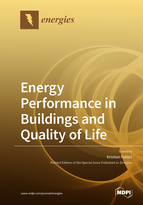Energy Performance in Buildings and Quality of Life
A special issue of Energies (ISSN 1996-1073). This special issue belongs to the section "G: Energy and Buildings".
Deadline for manuscript submissions: closed (31 March 2020) | Viewed by 30885
Special Issue Editor
Interests: heritage building; indoor and outdoor microclimates; building energy performance; monitoring campaign; building simulation; cultural heritage
Special Issues, Collections and Topics in MDPI journals
Special Issue Information
Dear Colleagues,
The field of research concerning building energy performance (BEP) encompasses a variety of issues: BEP and building typologies (e.g., schools, dwellings, social housing, heritage, etc.); the relationships between BEP and energy monitoring, energy consumption, and architectural design; and the impact of specific building techniques or materials on BEP.
In this Special Issue, we are highlighting the relationship between BEP and quality of life in terms of comfort (thermal comfort and IAQ), architectural design, and household smartness (smart building, smart monitoring, or smart metering, following UE Directive 844/2018), as well as the reduction of energy poverty and the impact of buildings on the environment and global warming.
Although the above list provides examples of specific topics of interest, our aim is, more broadly, to collect papers discussing the role of BEP in quality of life improvement. We look forward to your contributions.
Prof. Kristian Fabbri
Guest Editor
Manuscript Submission Information
Manuscripts should be submitted online at www.mdpi.com by registering and logging in to this website. Once you are registered, click here to go to the submission form. Manuscripts can be submitted until the deadline. All submissions that pass pre-check are peer-reviewed. Accepted papers will be published continuously in the journal (as soon as accepted) and will be listed together on the special issue website. Research articles, review articles as well as short communications are invited. For planned papers, a title and short abstract (about 100 words) can be sent to the Editorial Office for announcement on this website.
Submitted manuscripts should not have been published previously, nor be under consideration for publication elsewhere (except conference proceedings papers). All manuscripts are thoroughly refereed through a single-blind peer-review process. A guide for authors and other relevant information for submission of manuscripts is available on the Instructions for Authors page. Energies is an international peer-reviewed open access semimonthly journal published by MDPI.
Please visit the Instructions for Authors page before submitting a manuscript. The Article Processing Charge (APC) for publication in this open access journal is 2600 CHF (Swiss Francs). Submitted papers should be well formatted and use good English. Authors may use MDPI's English editing service prior to publication or during author revisions.
Keywords
- Building energy performance
- Thermal comfort
- IAQ
- Quality of life
- Smart building
- Energy poverty
- Households






